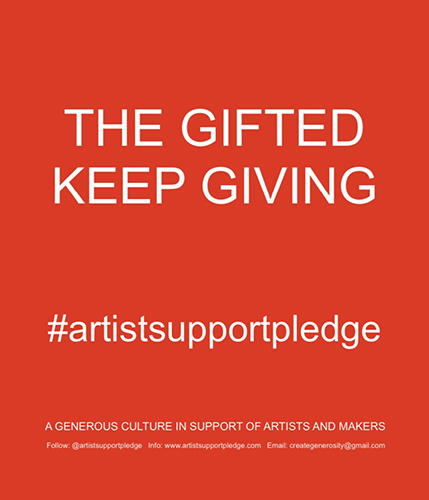In March 2020, as the COVID pandemic started, artist Matthew Burrows launched the Artist Support Pledge online, on the image-sharing platform, Instagram. It was a forward-thinking response to the economic collapse that artists were about to experience – it works with the principle that generosity is infectious.
The idea is simple: artists post an image of their work on Instagram and tag it with #artistssupportpledge so that the pictures can all be found in the same place. They offer their work for sale at a price up to £200 and they pledge that, when they have made £1,000 from pledge sales, they will spend £200 on another artist’s work.
If you have ever had a market stall, you will know the experience of spending your takings on your neighbours’ stalls. And the ability to do that is part of the pleasure of trading.
But it is not just the makers who are buying work. Money is coming into the system from outside, which it would have to, otherwise the artists would have lots of each other’s pictures on the walls but no bread in the toaster.
The idea uses the intent of the gift economy: that you, the artist, are passing on the £200 and this act connects you to your community and makes sure you all get to eat.
On the wall in front of me, I have ‘the Why Cheap Art manifesto’ issued by Bread and Puppet theatre, Vermont, in 1984. It says: ‘PEOPLE have been THINKING too long that art is a PRIVILEGE of the MUSEUMS & the RICH. ART IS NOT BUSINESS! It does not belong to banks & fancy investors. Art is food. You can’t EAT it BUT it FEEDS you. ART has to be CHEAP & available to EVERYBODY. It needs to be EVERYWHERE because it is the INSIDE of the WORLD. ART SOOTHES PAIN! Art wakes up sleepers! ART FIGHTS AGAINST WAR & STUPIDITY! ART SINGS HALLELUJA! ART IS FOR KITCHENS! ART IS LIKE GOOD BREAD! Art is like green trees! Art is like white clouds in blue sky! ART IS CHEAP! HURRAH!’
This has been a struggle for many artists in capitalist cultures. Bread and Puppet theatre baked and gave away bread at their performances. Art sits very comfortably in the gift economy, the artist gives away pleasure and meaning. But does an artist’s work fit into capitalism and how does an artist eat bread?
The Artist Support Pledge (ASP) website explains that one inspiration for the culture of the project comes from Kalahari and Aboriginal hunter-gatherers ‘who lived in harmony with their customs, community and environment for tens of thousands of years’: ‘It is the example of these communities – so often oppressed and brutalised by the “developed” world – that is guiding ASP into thinking again about what it means to be successful, sustainable and equitable.’
Two of the principles which inspire ASP are:
- 'The division of meat across the community. (Whoever makes the kill has the honour of dividing that meat amongst their family and neighbours, who in turn do the same until the whole community is fed.)'
- 'The campfire as a place of accommodation to anyone who is without food (just turn up and you will be fed).'
Matthew Burrows told the Studio International website: ‘I like the idea that if all of us, as artists, implicitly support one another by handing on some of what we have, by handing on a bit of our meat, then everyone will get fed. And I couldn’t, in my wildest dreams, have imagined it would grow at the rate it did and be as successful as it has been.’
In its first month, it is estimated that the Artist Support Pledge generated £15 million of sales.
An economist could tell me if this form of wealth-sharing is more like Islamic zakat than a First Nations potlatch, but this year artists have been economic leaders in a shift during this pandemic from accumulation to dispersal of wealth.


